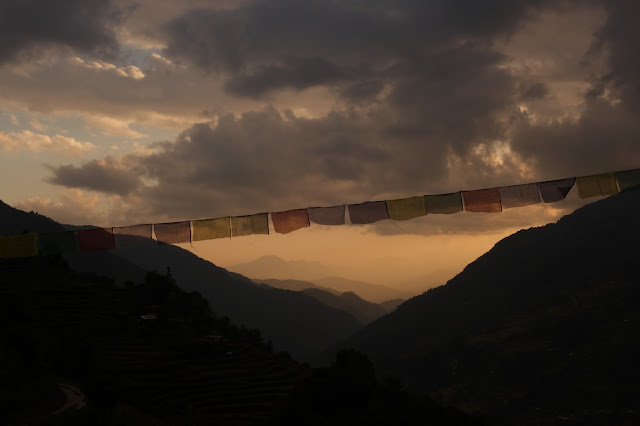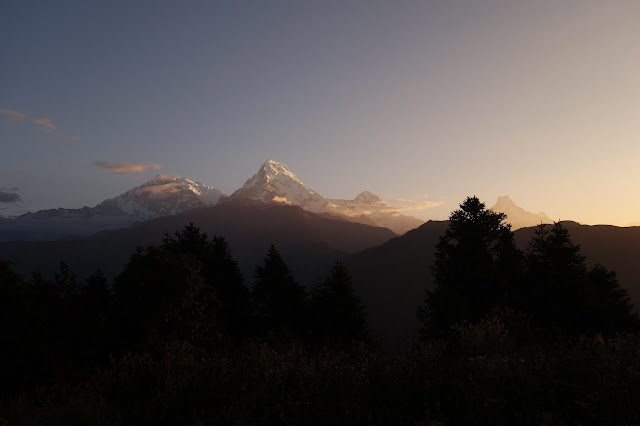I'm not even sure how to begin this post. I guess I'll start with a warning that it will be long and detailed with probably too many pictures. Although, how can I choose fewer when everything is beautiful? I want to inspire everyone I know to make this journey. OK, without further ado, here is our account of 28 days around the Annapurna Circuit.
We knew we wanted to go on this trek upon arriving in Nepal. It is reported to be one of the most beautiful in the world. It is also a very popular one that every trekking company in Nepal advertises. You can easily do it without a guide or porter, and many do. However, this was our first long distance hike, and tourism is down 70% in Nepal due to the 2015 earthquake. We felt it was better to hire a guide to support the local economy. So, our first big challenge was to find the right company to work with, of which there is an overabundance. Kathmandu is a bombardment of potential companies, and there certainly isn't a shortage of them in Pokhara either. We spent a lot of time researching the right company who has great reviews, has years of experience, and treats their guides and porters well. Eventually, we narrowed it down to a company called Beauty Nepal. The owner was very good at responding to all of our questions and working with us to craft the best trip. Our guide Kaji and his partner in crime, Milan, were very knowledgeable and pleasant to spend time with.
Our trip started October 1st with a packed, long, and crazy bus ride to Besisahar, the typical starting point of this trek. It was where we began our walking and steady climb to the highest mountain pass in the world, Thorung La. The first few days were spent climbing up and down steep hills to avoid the road built from Besisahar to Manang. We hiked among small villages adorned with slate walkways and surrounded by steep terraced hills. The locals greeted us with smiles, and the children pressed their hands together saying, "Namaste." The countryside was so green with the rice and millet not yet ready for harvest. Down below us wound the same river we'd follow for some time, right to its mountainous source. We only occasionally crossed it on long suspension bridges.
Eventually, the valley narrows and we follow a now raging, wild river up a ravine. We pass several massive and beautiful waterfalls, some flowing over the very path we hike on. Just when we think the valley cannot get any narrower, we haul ourselves up the last steep trail and it opens up into a new, wide valley where the river meanders toward the narrow passage behind us. It was breathtaking! From there, it's like we are suddenly in a whole new country as the terrain changes rapidly from jungle to the beginnings of alpine. Loamy pine forests remind us of home, and in the distance are some of the first great glimpses of mountains.
As we increased in elevation the temperature dropped, the vegetation grew more sparse, and the valley began to get narrow again. We had an acclimatization day in a village called Braka where we climbed to a viewpoint with stunning scenery of the river, the valley, and a monastery built into the hillside. This was also our first sighting of fluffy yaks. Every morning from there on we woke to incredibly monstrous mountains all around us. It seemed that every day was new, refreshing scenery. After 11 days, we finally made it to Thorung Phedi, the last town before going over the pass. I'm not sure if I was giddy from actually making it that far or the staggering altitude of 14,800 feet, but I felt great being there. Thorung Phedi is a bowl of rock and dust at the base of the Annapurna mountains where the river begins its journey back to where we started. The guesthouse beds were comfortable yet basic, the food was good, and the coffee was great. It was a great, relaxing place to spend the night before rising early for the hike over to the other side.
The time had come to make the ascent for Thorung La. We woke up in the wee hours of the morning and followed the many other headlamps twinkling up the steep trail to high camp and beyond. It got increasingly difficult to move our feet and catch a full breath of air the higher we went. There was fresh snow on the ground when we left Thorung Phedi, and by the time we reached high camp our Camelbak straws were frozen. It was cold. It was difficult. However, when the sun started to glimmer on the horizon, it was stunning. We were distracted enough to not care and push on. We were surrounded by mountain peaks that gradually turned from twilight blue to pink to shining gold and orange. Just when we thought, "how much more up can we possibly go?" We came over the last Ridge, and saw the hundreds of prayer flags blowing in the wind next to a sign congratulating us. We made it! We made it to the highest pass in the world at 17,769 feet of elevation. We were ecstatic albeit gasping for breath, dizzy from the effort and lack of oxygen, and freezing in the bitter wind. We took a few quick photos and promptly hit the trail again, as we had several more hours to go before reaching our destination for the day. The views didn't stop at the top of the pass, however. As we wound our way down the steep back side of the pass, we were awarded with phenomenal scenery of the drier side of the mountains. Snow fields led on to desert hills and more peaks in the distance. After 6.5 hours, we were on the other side sipping tea and looking up in awe at what we had just done.
It's all down hill from there, right? That's what I kept telling myself. Not quite. For the next few days we got a great glimpse of what the upper Mustang region is like, another popular hiking area. It was some of the most beautiful desert scenery I have seen. We made our way down a valley and along a very wide and meandering river bed. The gray rocky river was a stark contrast to the brown hills and vibrant blue sky. We passed through several wonderful villages that were built along the river, and seemed to be all made of stone and mud. There were some long days, but it was always beautiful to look at. Our guide did his best to find paths that avoided the dusty, busy road built along much of the main trail. We definitely appreciated the effort.
Desert gave way to trees again as we quickly descended. It seemed that we went from Eastern Washington to Western Washington in one day. Soon green pines interspersed with yellowing alder and the occasional apple tree were a common sight. In fact, Marpha is well known for its apples, of which we saw boxes hauled by truck or mule all over that side of the mountains. At some point, mud homes turned into moss covered slate homes. We saw less fluffy goats and more hairless water buffalo. The temperature got warmer and the road less dusty. We had a well deserved rest day in a village with hot springs before beginning to go up again for the second part of our journey.
Most people who do the Annapurna Circuit catch a bus back to Pokhara somewhere between Jomsom and Tadopani. We decided to torture ourselves and keep going, for some reason. The original plan was the hike the circuit plus Annapurna Base Camp, but it was peak tourist season and we had heard it was crazily crowded. Therefore, our guide suggested we do the Mardi Himal Trek instead. It is more remote and takes the same amount of time. So... Up, up, up we went again. We weren't disappointed.
We were in the hot jungle again, and spent the first several days of this part traversing hillsides. It felt like we were constantly going up one side then down another only to go back up again. It was this part that we learned the meaning of Nepali flat: a little up, a little down. Being back in warmer temperatures, the green hills were vibrant green again with a touch of yellow as harvest time was getting closer. We spent a morning walking up to the Poonhill viewpoint in Ghorepani, one of the easiest spots to hike to with a full view of the Annapurna mountains. At sunrise we stood with hundreds of other people packed onto a tiny hilltop, all taking photos of one of the most gorgeous panoramic views. I now understand why this viewpoint is so popular.
From there we headed up into the alpine, quickly gaining altitude again all of the way up to Mardi Himal High Camp and a little beyond to a viewpoint. It took us only a few days to make our way up, which was easier than climbing the pass. Unfortunately, it was socked in by clouds most days. However, there was a window of time every morning where you'd suddenly be rewarded with the sight of enormous, close mountains. This forced us to wake up early again for stunning sunrise views. We were looking up at Annapurna South and Machapuchare, both base camps visible to us in the distance. The steep hills we hiked on were covered in low grass that rapidly fell away to cliffsides and rolling hills toward Pokhara. We were practically alone up there, proving how remote it was.
That was the last uphill. It was truly all downhill from there. It was a short 3 days to get back to Pokhara with one last sunrise viewpoint at Sarangkot. We had already spent nearly a week there previously, so we were more anxious to get back to the city. I was longing for a hot shower, since I got only cold ones in the full 28 days of hiking. We also hoped for some food that was not the standard mountain village menu. We arrived in town just in time for Diwali with 5 days of marigold garlands, dancing in the streets, and children singing at storefronts. Animals are given garlands and food, and beautiful designs are painted outside of storefronts. What a cheery time to return.
Here is a full Elevation Profile from start to finish:
Here is a day to day breakdown of the trek:
Average food prices: 500-700 Rupees per meal
Average tea prices: 50-100 Rupees per cup
Average Guesthouse prices: 500-1000 Rupees for double room per night
Extras: Snickers bars 150 Rupees, Pringles 300 Rupees, Beer 450 Rupees
Reflecting back on the whole 28 days, I am glad I did it. There were some hard days, but more good than bad. I have such a great sense of accomplishment after completing something this epic, something way beyond anything I've ever done before. Even though hundreds of people cross Thorung La every day, I can now count myself among them and I feel like I can do anything. We had a great guide, the friendliest and toughest porter, and met many wonderful people along the way.









































































No comments:
Post a Comment